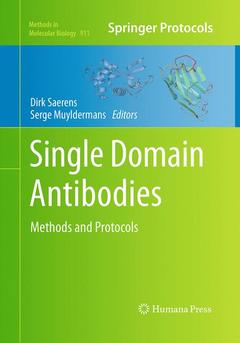Description
Single Domain Antibodies, Softcover reprint of the original 1st ed. 2012
Methods and Protocols
Methods in Molecular Biology Series, Vol. 911
Coordinators: Saerens Dirk, Muyldermans Serge
Language: English
Subject for Single Domain Antibodies:
Keywords
Heavy chain antibodies; Single variable domain; V-NAR; VHH; sdAbs; antibodies
Publication date: 08-2016
Support: Print on demand
Publication date: 08-2012
580 p. · 17.8x25.4 cm · Paperback
Description
/li>Contents
/li>Comment
/li>
From Whole Monoclonal Antibodies to Single Domain Antibodies: Think Small.- Introduction to Heavy Chain Antibodies and Derived Nanobodies.- Overview and Discovery of IgNARs and Generation of VNARs.- Creation of the Large and Highly Functional Synthetic Repertoire of Human VH and Vκ Domain Antibodies.- Preparation of a Naïve Library of Camelid Single Domain Antibodies.- Selection by Phage Display of Single Domain Antibodies Specific to Antigens in Their Native Conformation.- Semi-Automated Panning of Naive Camelidae Libraries and Selection of Single-Domain Antibodies Against Peptide Antigens.- Pichia Surface Display: A Tool for Screening Single Domain Antibodies.- Bacterial Two Hybrid: A Versatile One-Step Intracellular Selection Method.- Intracellular Antibody Capture (IAC) Methods for Single Domain Antibodies.- Selection of Functional Single Domain Antibody Fragments for Interfering with Protein-Protein Interactions Inside Cells: A “One Plasmid” Mammalian Two-Hybrid System.- Cell-Free Selection of Domain Antibodies by In Vitro Compartmentalization.- Selection of VHHs Under Application Conditions.- Isolation and Characterization of Clostridium difficile Toxin-Specific Single-Domain Antibodies.- Selection of VHH Antibody Fragments that Recognize Different Aβ Depositions Using Complex Immune Libraries.- Expression of Single-Domain Antibodies in Bacterial Systems.- Expression of VHHs in S. cerevisiae.- Stable Expression of Chimeric Heavy Chain Antibodies in CHO Cells.- Production of Camel-Like Antibodies in Plants.- Selecting and Purifying Autonomous Human Variable Heavy (VH) Domains.- Solubility and Stability Engineering of Human VH Domains.- Improvement of Proteolytic Stability through In Silico Engineering.- Selection of Human VH Single Domains with Improved Biophysical Properties by Phage Display.- Improvement of Single Domain Antibody Stability by Disulfide Bond Introduction.- Characterization of Single-Domain Antibodies withan Engineered Disulfide Bond.- Affinity Maturation of Single-Domain Antibodies by Yeast Surface Display.- Multivalent Display of Single-Domain Antibodies.- Methods for Determining the PK Parameters of AlbudAbs and of Long Serum Half Life Drugs Made Using the AlbudAb Technology.- Fluorescent Protein Specific Nanotraps to Study Protein-Protein Interactions and Histone-Tail Peptide Binding.- Site-Specific Labeling of His-Tagged Nanobodies with 99mTc: A Practical Guide.- Nanobody-Based Chromatin Immunoprecipitation.- User-Friendly Expression Plasmids Enable the Fusion of VHHs to Application-Specific Tags.- Application of Single Domain Antibodies in Tumor Histochemistry.- Nanobodies as Structural Probes of Protein Misfolding and Fibril Formation.- Molecular Imaging Using Nanobodies: A Case Study.- Case Study on Live Cell Apoptosis-Assay Using Lamin-Chromobody Cell-Lines for High-Content Analysis.
These books may interest you

ELISAMethods and Protocols 168.79 €

ELISAMethods and Protocols 121.31 €


